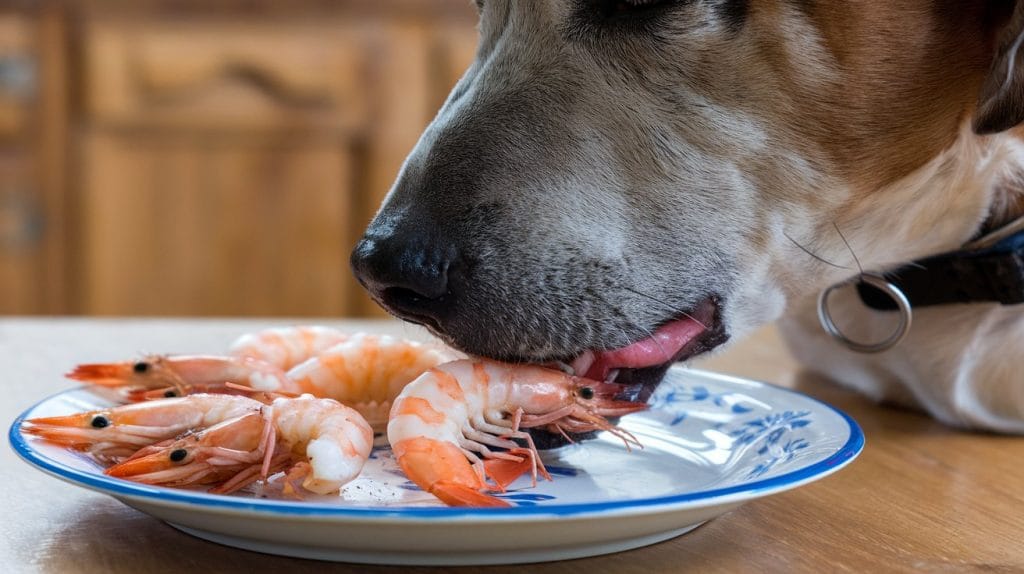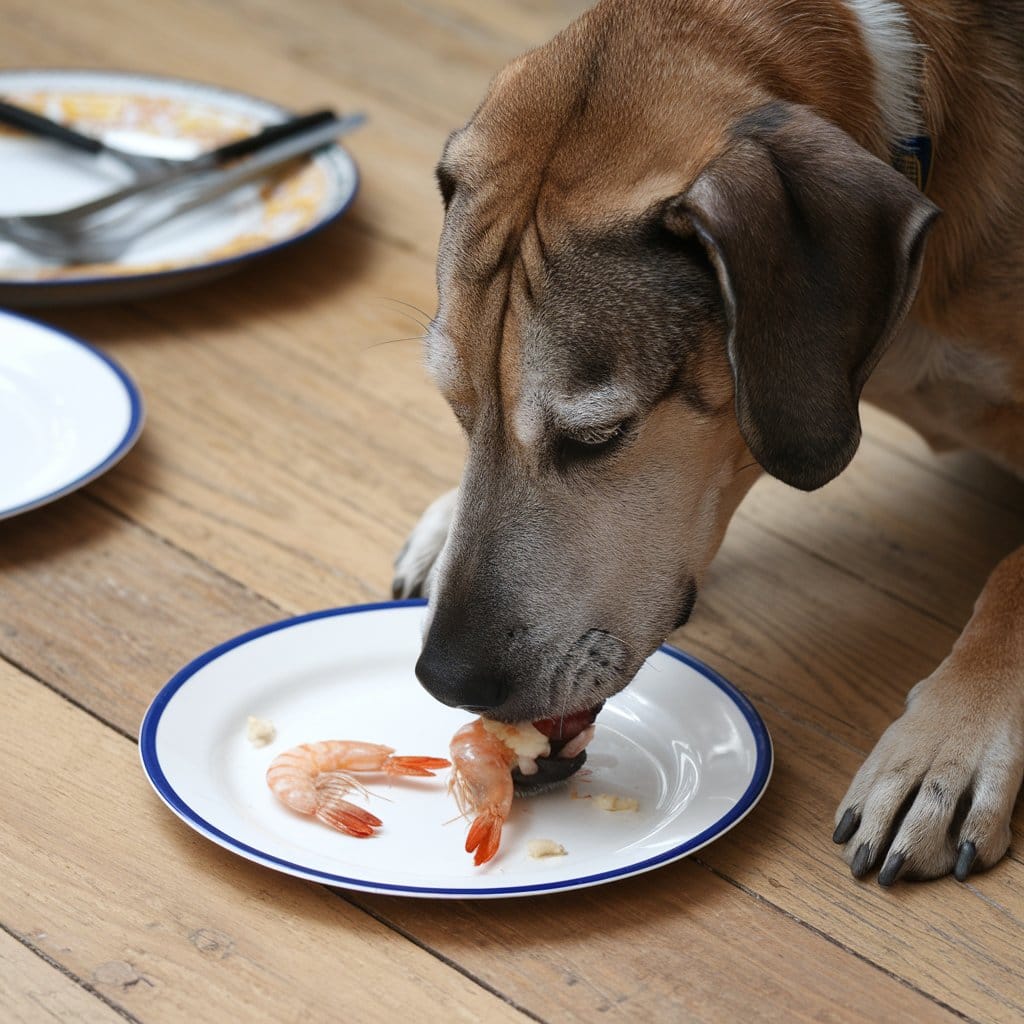Many pet owners wonder: can dogs eat shrimp? This question has sparked debate about what to feed our dogs. We’ll look into the good and bad of giving shrimp to dogs. We’ll also share tips on how to safely add it to their diet.
A playful dog curiously sniffing a bowl of shrimp on a beach, with fresh seafood and ocean waves in the background, showcasing a vibrant and sunny atmosphere.
Humans often eat shrimp, making us curious if dogs can too. While there are risks like allergies and choking, shrimp can be good for dogs if done right. It can be a nutritious treat for them.
Table of Contents
Introduction to Feeding Shrimp to Dogs
Feeding shrimp to dogs is a topic of debate. Some pet owners believe it’s good for their pets, while others worry about health risks. We’ll look at the good and bad sides of giving shrimp as a treat to dogs.
Why Shrimp is a Controversial Dog Food
Shrimp is a seafood that sparks debate in dog diets. Some worry about allergies, choking, and stomach issues. Yet, others see shrimp as a nutritional boost for dogs.
Nutritional Benefits of Shrimp for Canines
Shrimp is low in fat but high in protein, making it great for dogs. It’s packed with vitamins and minerals like vitamin B12, phosphorus, and iodine. These help with everything from immune health to thyroid function. Plus, omega-3 fatty acids in shrimp can fight inflammation and keep skin and coat healthy.
| Nutrient | Amount in Shrimp (per 100g) | Benefits for Dogs |
|---|---|---|
| Protein | 24g | Supports muscle development and maintenance |
| Vitamin B12 | 2.2μg | Supports red blood cell formation and nervous system function |
| Phosphorus | 205mg | Supports bone and tooth health |
| Iodine | 40μg | Supports thyroid function and metabolism |
| Omega-3 Fatty Acids | 0.3g | Reduces inflammation and promotes healthy skin and coat |
Shrimp has many nutritional benefits for dogs. But, it’s key to weigh the risks and talk to a vet before adding it to your dog’s diet.
Can Dogs Eat Shrimp?
Many pet owners wonder if dogs can safely eat shrimp. Shrimp can be good for dogs, but there are risks to think about too.
Feeding shrimp to dogs can lead to allergic reactions. Some dogs might be allergic to shellfish, causing stomach problems, skin issues, or even anaphylaxis. Always be careful and watch how your dog reacts to shrimp.
| Potential Benefits of Shrimp for Dogs | Potential Risks of Shrimp for Dogs |
|---|---|
| High in proteinRich in omega-3 fatty acidsGood source of vitamins and minerals | Allergic reactionsChoking hazard from the shellsDigestive issues due to high fat and sodium content |
Shrimp shells and tails can also be a choking risk for dogs. The high fat and sodium can upset their stomachs. Make sure to remove the shells and tails and give only small amounts of shrimp.
Deciding if dogs can eat shrimp is complex. It depends on the dog’s health, diet, and allergies. Always talk to your vet before adding shrimp or any new food to your dog’s diet.
Potential Risks of Feeding Shrimp to Dogs
Feeding shrimp to dogs can be good for their health, but owners need to know the risks. It’s important to be careful when adding shrimp to a dog’s diet.
Shellfish Allergies in Dogs
Feeding shrimp to dogs can lead to allergic reactions. Some dogs might be allergic to shellfish, just like people. Signs of an allergy include itching, hives, stomach problems, and even anaphylaxis, which is very serious.
Watch your dog closely if you give them shrimp for the first time. Stop feeding it to them if they show any bad reactions.
Choking Hazards and Digestive Issues
Shrimp can be a choking risk, especially for small dogs or those with dental issues. It’s also high in protein and fat, which can upset some dogs’ stomachs. This might cause vomiting, diarrhea, or pancreatitis.
To avoid these problems, chop or puree the shrimp before giving it to your dog. Start with small amounts to see how they handle it. Talking to your vet can also help make sure shrimp is safe for your dog.https://www.youtube.com/embed/1ju0mhwhxF0
“Responsible pet owners should always exercise caution when introducing new foods, including shrimp, to their dog’s diet.”
Preparing Shrimp Safely for Your Dog
Feeding shrimp to your dog needs careful preparation to be safe and healthy. Dogs can enjoy shrimp, but we must take steps to avoid health risks.
First, clean and cook the shrimp well. Raw or undercooked shrimp can make dogs sick. Boiling or steaming the shrimp until it’s fully cooked is the safest approach. Don’t add spices, sauces, or other additives, as they can harm dogs.
Think about the shrimp size and amount. Bite-sized, peeled, and deveined shrimp are best for dogs. Large, unpeeled shrimp can choke them or be hard to digest. Limit the shrimp to a small portion, no more than a few pieces per serving, to prevent stomach upset.
| Preparation Step | Recommendation |
|---|---|
| Cleaning | Thoroughly rinse and clean the shrimp to remove any dirt or bacteria. |
| Cooking | Boil or steam the shrimp until fully cooked, without any additional seasonings. |
| Portion Size | Serve bite-sized, peeled, and deveined shrimp in small portions, no more than a few pieces per serving. |
By following these steps, you can safely add shrimp to your dog’s diet. They’ll get a tasty and nutritious treat they’ll love.
Healthy Shrimp Recipes for Dogs
Adding shrimp to your dog’s diet needs careful planning. Here are two tasty and healthy shrimp recipes that dogs can safely eat.
Simple Boiled Shrimp Recipe
This easy shrimp dish is perfect for introducing shrimp to your dog. Just boil the shrimp without seasonings or oils. It makes a great, protein-rich snack.
- Peel and devein 1 pound of raw shrimp.
- Bring a pot of water to a boil and add the shrimp.
- Cook the shrimp for 2-3 minutes, until they turn pink and opaque.
- Drain the shrimp and let them cool slightly before serving.
Shrimp and Vegetable Stir-Fry
For a fuller shrimp dish, try this stir-fry with veggies. It makes a balanced meal for your dog.
- 1 pound of raw shrimp, peeled and deveined
- 2 cups of chopped mixed vegetables (such as broccoli, carrots, and bell peppers)
- 1 tablespoon of low-sodium chicken or beef broth
In a large skillet or wok, cook the veggies in broth for 5-7 minutes, until they’re tender. Add the shrimp and cook for 2-3 more minutes, until the shrimp are fully cooked. Let it cool a bit before giving it to your dog.
When making shrimp recipes for dogs, remember to skip any seasonings, oils, or harmful ingredients. Use whole foods simply to keep your pup safe and happy.
Moderation is Key When Feeding Shrimp to Dogs
Feeding shrimp to dogs can be good for their health, but remember, moderation is key. Giving them too much shrimp can lead to health problems. It’s important to know how much and how often to feed them.
Experts suggest that shrimp should make up no more than 10% of your dog’s daily calories. For a 20-pound dog, that’s about 1 to 2 tablespoons of shrimp. Bigger dogs might get a bit more, but always check with your vet to find the right amount for your pet.
| Dog’s Weight | Recommended Shrimp Portion |
|---|---|
| 10 lbs | 1/2 to 1 tablespoon |
| 20 lbs | 1 to 2 tablespoons |
| 30 lbs | 2 to 3 tablespoons |
| 40 lbs | 3 to 4 tablespoons |
Don’t make shrimp a regular or daily food for your dog. Treat it as an occasional snack or add it to their meals sometimes. This way, your dog can enjoy shrimp safely and get its health benefits without any risks.

A visually appealing illustration of a dog looking curiously at a small bowl of shrimp, with several shrimp around the bowl, set on a clean countertop. The scene includes a measuring cup beside the bowl, indicating moderation in portion size. Soft natural lighting enhances the colors, creating a warm atmosphere. The background features subtle hints of a kitchen setting without any distractions.
By following these tips and talking with your vet, you can add shrimp to your dog’s diet safely. This lets them enjoy the tasty seafood while staying healthy.
Signs Your Dog Shouldn’t Eat Shrimp
Shrimp can be good for dogs, but owners need to watch out for risks. It’s key to keep an eye on how your dog reacts to shrimp in their diet.
Monitoring for Adverse Reactions
When you give shrimp to your dog, look for these signs they might not like it:
- Gastrointestinal distress: Vomiting, diarrhea, or belly pain could mean the shrimp is hard for your dog to digest.
- Allergic responses: Hives, itching, swelling, or trouble breathing might show an allergy to the shellfish.
- Choking hazards: If your dog has trouble chewing or swallowing the shrimp, it could be a choking risk.
- Pancreatitis: Shrimp’s high fat can cause this serious and painful condition in some dogs.
If you see any of these signs after giving shrimp to your dog, stop feeding them right away. Call your vet. Your dog’s health and safety are most important.
Watching how your dog reacts to shrimp and acting fast can make sure they stay safe and happy.
Alternative Seafood Options for Dogs
Shrimp can be a tasty treat for some dogs, but it’s good to look at other seafood options. These can be safer and better for your dog. There are many types of fish that give your dog important nutrients without the risks of shrimp.
Safe Fish Types for Canine Consumption
For dogs, it’s wise to choose fish that are low in mercury and easy to digest. Here are some safe fish choices:
- Salmon: High in omega-3 fatty acids, which can help reduce inflammation and support a healthy coat.
- Tuna: A lean protein source that is rich in vitamins and minerals, but should be fed in moderation due to mercury concerns.
- Whitefish: Such as cod, halibut, or tilapia, which are gentle on the digestive system and offer a variety of nutrients.
- Sardines: A small, oily fish that is packed with omega-3s, vitamin D, and other essential vitamins and minerals.
Always talk to your vet before adding new seafood or human foods to your dog’s diet. Every dog is different, and their dietary needs and sensitivities can vary.
| Fish Type | Nutritional Benefits for Dogs | Potential Concerns |
|---|---|---|
| Salmon | High in omega-3 fatty acids, vitamins, and proteins | May contain small bones that could pose a choking hazard |
| Tuna | Lean protein source, rich in vitamins and minerals | Higher in mercury compared to other fish, should be fed in moderation |
| Whitefish | Gentle on the digestive system, offers a variety of nutrients | May contain small bones that could pose a choking hazard |
| Sardines | High in omega-3s, vitamin D, and other essential nutrients | May contain small bones that could pose a choking hazard |
By looking at these other seafood options for dogs, you can give your dog healthy and safe seafood choices. Always add new foods slowly and watch for any bad reactions.
Consulting with Your Veterinarian
Before adding shrimp or any new food to your dog’s diet, talk to a licensed vet. Vets know a lot about what dogs need to eat and can help with adding shrimp safely. They look at your dog’s health, what it needs to eat, and watch out for allergies.
Your vet can tell you the right amount, how to prepare it, and how often to feed shrimp to your dog. They can also suggest what to watch for to keep your dog healthy. This way, you can be sure you’re giving your dog a diet that’s good for them and includes shrimp safely.
Getting advice from your vet is key when it comes to veterinarian advice on feeding shrimp to dogs. Their advice helps you make smart choices and keeps your dog happy and healthy for a long time.





